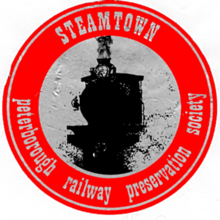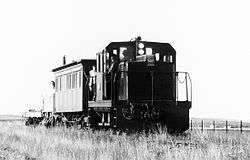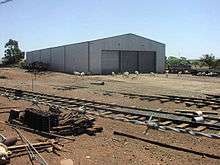Steamtown Peterborough Railway Preservation Society
 | |
| Established | 1977 |
|---|---|
| Dissolved | 2002 |
| Location | Peterborough |
| Coordinates | 32°34′57″S 138°30′03″E / 32.5826°S 138.5007°ECoordinates: 32°34′57″S 138°30′03″E / 32.5826°S 138.5007°E |
| Type | Railway museum |
The Steamtown, Peterborough Railway Preservation Society, Inc. (also known as Steamtown or Steamtown Peterborough, and referred to as the Society in this article) was a not-for-profit society which operated a heritage steam railway from Peterborough, South Australia north along a section of the Peterborough to Quorn railway line.
The Society operated from the former South Australian Railways Peterborough roundhouse and purpose-built sheds and yard at Peterborough West.
Foundation
The Society was founded in 1977 to run a steam-hauled tourist train service on the Peterborough–Quorn railway line narrow gauge railway between Peterborough and Eurelia using steam locomotive T199.
The Society was said to have arisen from the successful return to steam of sister T186,[1] and the highly regarded Peterborough Centenary celebrations of 1976.[2][3]
Rolling stock

All of the Society's revenue passenger rolling stock was formerly Commonwealth Railways. All had seen service on the narrow-gauge Central Australia Railway between Marree and Alice Springs. All of its steam locomotive fleet was from the Western Australian Government Railways, including Pmr720, and W901 and W907 (W907 was never steamed).
Diesel power was initially also Western Australian, comprising Commonwealth Railways NC1 (which was originally in the Lakewood Firewood Company's service in WA) and Western Australian Government Railways Z1151. The Society obtained Commonwealth Railways NSU class locomotives 55 and 62, from those remaining at Marree, during 1993. These were delivered in January 1994.[4]
Early trains were run with Pmr720. However, tubes in this locomotive failed in the late 1980s,[5] leaving W901 as the only operational steam locomotive. Plans were made to recommission Pmr720, but this never eventuated.
Tender-first operations, minimalist maintenance and limited expertise[5] led to problems with W901 in later years, with a number of trains being diesel hauled, or supported by small diesel power. Following the last train, W901 was left full of water, causing concern regarding the condition of her boiler. Former Steamtown Peterborough Railway Preservation Society members, including those involved with the recommissioning, undertook minor works in 2006 to minimise further deterioration.[6]
NSU55 was eventually recommissioned during 1998 after a considerable effort by a small band of volunteers. Major problems were encountered replacing failed cylinder liner seals.[4] Track conditions throughout the roundhouse and on the mainline created significant problems for its operation.[7] It is understood that it never worked more than a few kilometres out of Peterborough.
While T199 was the first locomotive to be obtained (on loan from the Corporation of Peterborough,[1] it was never steamed (being described as "sound condition", with a rusted tender[8]). This was, in part, because of the availability of roadworthy locomotives in WA, including the V, S, W and Pmr Class locomotives. Serious consideration was given to the heavy V and S classes, however track conditions and the operational pressures that they would have created ruled them out.[9][10] In the end, W901, W907 and Pmr720 were purchased and shipped to Peterborough for a total of $25,200.[10]
Another extant steam locomotive in Peterborough, Y82, was never transferred to the Society. It was given a cosmetic restoration in 1999, and was moved to a plinth in Peterborough.[11]
Operating facilities

In the early days of the Society, Australian National allowed rolling stock to be stored within its roundhouse.
The Society saw the need to establish its own facilities, and proposed to establish its own depot on a block of land bordered by the Quorn line, the town's Main Street, and the railway dam. This was seen as an ideal site, as it had mains water, power, sewage; this was perhaps a result of it being the site of the former railway hostel. It was proposed that, with little work, a triangle could be installed. Australian National agreed to provide the land at a nominal rent of $50.[12]
The depot was eventually located at the western end of Peterborough. Construction commencing on 10 June 1980. It is unclear why, after the efforts to locate the depot next to the railway, it was located here.[13] The depot was not connected and made rail-accessible until a number of working bees completed the track-laying during late 1983.[14]
The Society operated from its depot for a number of years, but moved most of its operational rolling stock into the roundhouse and diesel shop after the withdrawal of Australian National.
The move
In the early 1980s, a group of members, centred on the Society's committee, realised that the future of the organisation was limited in Peterborough, and investigated options for relocating the Society elsewhere. It is understood that the committee believed that limited tourist traffic in Peterborough was a primary issue, along with apparently limited support from the local community. Indeed, the Society suffered a severe loss of skills as "the railways" reduced its staffing in the town.[5][15][16]
Options considered were the Gladstone to Willmington line, also of 3'6" gauge, and at the time still carrying large quantities of grain, the Clare Valley line (which required re-gauging from 5'3" gauge), in order to take advantage of the tourism potential of the Clare Valley,[1] and the Victor Harbor line, with the main consideration being a base at Goolwa.[17] This line was later transferred to the management of the Australian Railway Historical Society.
An Act of Parliament
A number of issues within the organisation and the town eventually led to ownership of the rolling stock being transferred, following a Parliamentary Select Committee enquiry and subsequent Act of Parliament, to the Corporation of Peterborough, with operational responsibility for the rolling stock being vested in the Steamtown, Peterborough Railway Preservation Society.[18][19]
The operations of the Society never recovered from this. There were significant problems attracting people who had the skills and abilities needed to realise the potential of its operations.[16]
Operations
The first public train ran on 17 April 1981, as part of a weekend of celebrations.[20]

The organisation ran an average of six trips a year between Peterborough and Orroroo, and Peterborough and Eurelia.
Its peak years, in terms of train operations, was 1981 when it ran a total of 27 trains, including a trip to Quorn.[21] In subsequent years it ran up to eleven scheduled trains per year. During the late 1980s and 1990s, operations were suspended for short periods on a number of occasions, mainly due to motive power unavailability.
The Society ran one train to Quorn over the weekend of 17 and 18 October 1981; the last steam hauled train to travel the line between Peterborough and Quorn, home of the Pichi Richi Railway Preservation Society. Pmr720 was the only Pacific-type locomotive to visit Quorn.[2] The Society ran a number of other trains to Bruce, Hammond and Carrieton, using available NT class locomotives, to recover track and civil infrastructure. Much of this was used within the depot at Peterborough West.
The Society also hosted what were believed to be amongst the first organised motor section car excursions in the country. These ran between 1994 and 1998, in association with a live band at Eurelia.[4]
In the Society's last years of operation, a restored South Australian Railways Motor Inspection Car was available for hire.[22]
The Society had considerable problems attracting the patronage and technical skills necessary to support its operations. In its later years the majority of active volunteers came from outside the district.[23]
A last fling
The District Council of Peterborough supported a manager for the organisation in its later years, who made a significant contribution to turning around the organisation's fortune. However, the underlying problems and rapidly deteriorating assets, particularly civil, meant that the work done was too late to be of benefit to the Society despite the council's input of $199,000 towards maintaining the Society.[24]
At a meeting held in October 2004 to discuss the future direction of the Society, Mayor Whittle said "Contrary to rumor, council is not Hell-bent on closing Steamtown. It is realistic to say that trains are never likely to run again, due to issues such as track maintenance, insurance, lack of volunteers and money to do what other railway societies are doing".[24]
Prior to the cessation of train operations in June 2002, a steering committee, made up of the Federation of North East Councils, the Northern Regional Development Board, the Flinders Ranges Area Consultative Committee, and Society representatives was established. This led to a project to develop the workshops precinct as the Steamtown Heritage Rail Centre.[25]
The end
By 2002, insurance costs skyrocketed for most heritage railways, leading to a number ceasing operations. This affected the Society, which stopped the operation of its trains when its public liability cover expired in June 2002.[26] By the time the insurance crisis had resolved the following year, the Society was experiencing great difficulty pulling together a management committee.
The rollingstock and civil assets of the Society had received only limited maintenance, mainly as a consequence of lack of resources, including volunteers with appropriate expertise. As the track was last re-sleepered by the SAR in the late 1960s and early 1970s, it too was starting to deteriorate. At the meeting to discuss the Society's future, "facts were presented showing that since the 1970s, the Society had seriously underspent in maintenance on track infrastructure",[24] which was now a problem to be overcome before the trains could run again.
A report of the condition of the track was commissioned in order to establish the feasibility of resuming operations. The report suggested that the track needed major refurbishment at an estimated cost of $2.4 million.[27]
A business and marketing plan prepared by a consultant explored the financial viability of the operation under limited criteria.[27]
Despite claims by the District Council of Peterborough that its priority was the retention of the Society and its assets,[27] council minutes suggest that work had already commenced to plan the disposal of the assets entrusted to it as a result of events of the early 1980s.[28][29]
The proposal for disbandment was made at a public meeting in September 2003.[30] The Society was dissolved as a legal entity on 13 January 2005.
Work to remove the railway commenced on 14 September 2008 and was completed by 17 December of that year. Track was left over Pekina Creek, Black Rock Yard, Black Rock Bridge, Walloway Yard to Walloway Creek and in the yard of Orroroo.[31] The funds resulting from track removal, with some funds from the council, have been used to create the Steamtown Heritage Rail Centre with enhancements to the Roundhouse Complex and the development of a "Sound & Light Show".[32]
Black Rock Yard hosted the first of a proposed annual Kalamazoo race on 27 March 2010. The event was reported as being very successful.[33]
Today
The assets of the Society have been used to form the basis for the displays at Steamtown Heritage Rail Centre, which is managed by the council.
Notes
- 1 2 3 Woods, A 1986 "Petersburg to Peterborough: A Journey from 1875 to 1986" Peterborough and Local District History Club
- 1 2 Evans, J 2009 "Proceed to Quorn" Railmac Publications ISBN 978-1-86477-066-X
- ↑ "Steamtown Peterborough and the future of the Eurelia Line" 'Catchpoint September 2006
- 1 2 3 Various editions and Editors The Partyline (Steamtown Internal Magazine)
- 1 2 3 post to Railpage accessed 2 August 2015
- ↑ "PRR assist Steamtown to store W901" Pichi Richi Patter Autumn 2007
- ↑ "Track Report" 'The Partyline issue 76 Autumn 2001 Steamtown Peterborough Railway Preservation Society ISSN 1322-2473
- ↑ Attachment "T Fund" Steamtown Peterborough Railway Preservation Society newsletter issue 2 April 1979
- ↑ "'The V Class" The Partyline" edition 56, Winter 1994 Steamtown Peterborough Railway Preservation Society ISSN 1322-2473
- 1 2 "The Steamtown Locomotives" Steamtown Peterborough Railway Preservation Society newsletter issue 1 February 1979
- ↑ South Australian Railways Australian Steam
- ↑ "The Proposed Steamtown Locomotive Depot" Steamtown Peterborough Railway Preservation Society newsletter" issue 2 April 1979
- ↑ "The Steamtown Depot" Steamtown Peterborough Railway Preservation Society newsletter" issue 11 October 1980
- ↑ "Depot Site News" Steamtown Peterborough Railway Preservation Society newsletter" issue 24 January 1984
- ↑ "Steamtown - the Future - Conclusion" Newsletter - Number 7 -February 1980 Steamtown Peterborough Railway Preservation Society
- 1 2 "The Current Problems at Peterborough" Steamtown Peterborough Railway Preservation Society newsletter" issue 27 July 1984
- ↑ "Clare - Riverton Railway" Steamtown Peterborough Railway Preservation Society newsletter" issue 29 January 1985
- ↑ Steamtown Peterborough (Vesting of Property) Act 1986 Government of South Australia
- ↑ "Parliamentary Select Committee" Steamtown Peterborough Railway Preservation Society newsletter" issue 29 January 1985
- ↑ "Editorial" Steamtown Peterborough Railway Preservation Society newsletter" issue 16 July 1981
- ↑ "The 1981 Running Season" Steamtown Peterborough Railway Preservation Society newsletter" issue 17 January 1982
- ↑ "General News" The Partyline issue 76 Autumn 2001 page 3
- ↑ Various editions of the Partyline - from mid-1990s onwards - refer to discussion page
- 1 2 3 "Public discussion over Steamtown's future" Flinders News 8 October 2004
- ↑ "Presidents Report 26 October 2003" Steamtown Partyline Newsletter issue 78 Summer 2003
- ↑ "Public Liability Halts Trains" The PartyLine issue 78 Summer 2003 Steamtown Peterborough Railway Preservation Society ISSN 1322-2473
- 1 2 3 Public Discussion over Steamtown's Future Flinders News 8 October 2004
- ↑ District Council of Peterborough; Minutes of the ordinary council meeting 18 August 2003 District Council Minutes Retrieved 27 January 2010
- ↑ .Administrative Arrangements (Administration of Steamtown Peterborough (Vesting of Property) Act) Proclamation 2003 Accessed 26 February 2010
- ↑ Rail Preservation Society disbands Flinders News 31 October 2003]
- ↑ "Ripping up the tracks - Eurelia to Peterborough" "Catchpoint" March 2009 pages14-16
- ↑ Harvest time for the Eurelia rail line Flinders News 19 September 2008
- ↑ Back on the rails at Black Rock The Northern Argus
References
- McNicol, S, (Mannion, J) 2006: Peterborough 125 - Celebrating 125 years of Railways in Peterborough Railmac Publications, Elizabeth SA ISBN 978-1-86477-054-4
- Evans J 2006: "Proceed to Quorn" Proceedings of Modelling the Railways of South Australia 2006